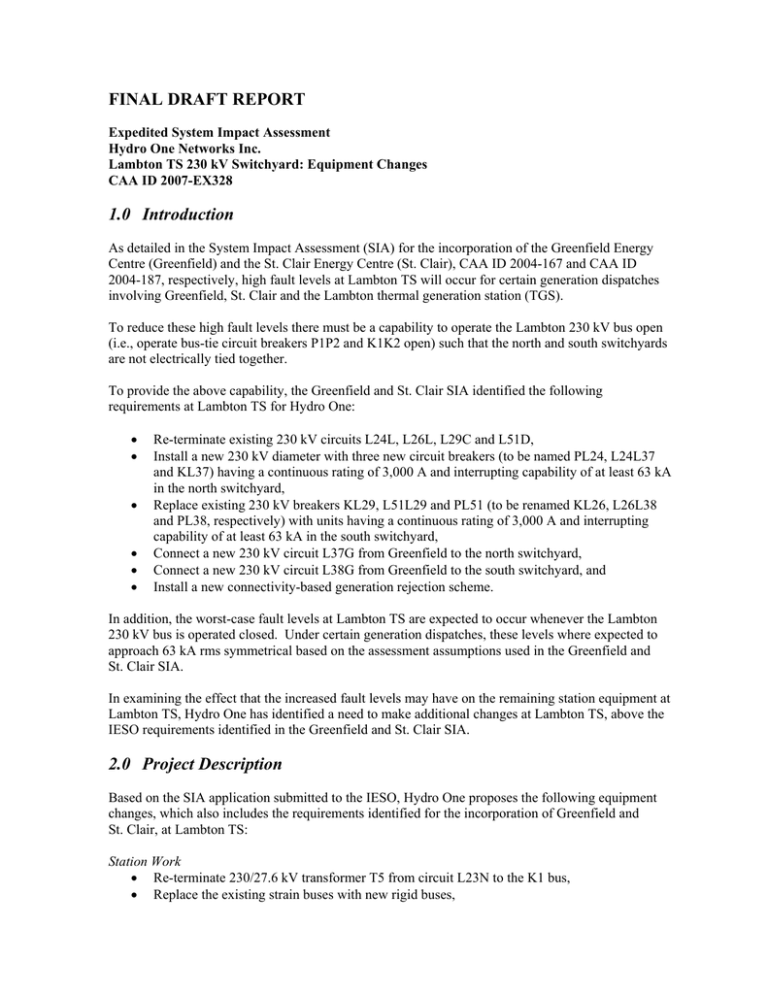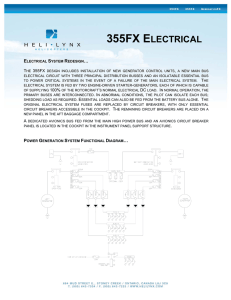FINAL DRAFT REPORT 1.0 Introduction 2.0 Project Description
advertisement

FINAL DRAFT REPORT Expedited System Impact Assessment Hydro One Networks Inc. Lambton TS 230 kV Switchyard: Equipment Changes CAA ID 2007-EX328 1.0 Introduction As detailed in the System Impact Assessment (SIA) for the incorporation of the Greenfield Energy Centre (Greenfield) and the St. Clair Energy Centre (St. Clair), CAA ID 2004-167 and CAA ID 2004-187, respectively, high fault levels at Lambton TS will occur for certain generation dispatches involving Greenfield, St. Clair and the Lambton thermal generation station (TGS). To reduce these high fault levels there must be a capability to operate the Lambton 230 kV bus open (i.e., operate bus-tie circuit breakers P1P2 and K1K2 open) such that the north and south switchyards are not electrically tied together. To provide the above capability, the Greenfield and St. Clair SIA identified the following requirements at Lambton TS for Hydro One: • • • • • • Re-terminate existing 230 kV circuits L24L, L26L, L29C and L51D, Install a new 230 kV diameter with three new circuit breakers (to be named PL24, L24L37 and KL37) having a continuous rating of 3,000 A and interrupting capability of at least 63 kA in the north switchyard, Replace existing 230 kV breakers KL29, L51L29 and PL51 (to be renamed KL26, L26L38 and PL38, respectively) with units having a continuous rating of 3,000 A and interrupting capability of at least 63 kA in the south switchyard, Connect a new 230 kV circuit L37G from Greenfield to the north switchyard, Connect a new 230 kV circuit L38G from Greenfield to the south switchyard, and Install a new connectivity-based generation rejection scheme. In addition, the worst-case fault levels at Lambton TS are expected to occur whenever the Lambton 230 kV bus is operated closed. Under certain generation dispatches, these levels where expected to approach 63 kA rms symmetrical based on the assessment assumptions used in the Greenfield and St. Clair SIA. In examining the effect that the increased fault levels may have on the remaining station equipment at Lambton TS, Hydro One has identified a need to make additional changes at Lambton TS, above the IESO requirements identified in the Greenfield and St. Clair SIA. 2.0 Project Description Based on the SIA application submitted to the IESO, Hydro One proposes the following equipment changes, which also includes the requirements identified for the incorporation of Greenfield and St. Clair, at Lambton TS: Station Work • Re-terminate 230/27.6 kV transformer T5 from circuit L23N to the K1 bus, • Replace the existing strain buses with new rigid buses, • • • • Replace all existing 230 kV air blast breakers (sixteen in total), associated free standing current transformers (CTs) and breaker disconnects with new SF6 breakers equipped with CTs and new breaker disconnects, Install three new SF6 breakers equipped with CTs and new breaker disconnects for the new diameter in the north switchyard, Replace all cap and pin insulators with post insulators, and Provide the necessary protective relaying, operating and statistical metering, and supervisory control facilities for all new equipment. Line Work • Re-terminate existing 230 kV circuits L24L, L26L, L29C and L51D, • Connect new 230 kV circuits L37G and L38G, • Install new 230 kV line disconnect switches and motorized ground switches for circuits L37G and L38G, • Replace or modify all existing ground switches for motorized control, • Replace all cap and pin insulators with post insulators, and • Provide the necessary protective relaying, operating and statistical metering, and supervisory control facilities for all new equipment. Circuit L51D will be re-terminated by opening a section of the rigid bus at its present location and connecting it to the north switchyard via a new 230 kV underground cable 250 m long. Circuits L24L, L26L and L29C will be re-terminated by interchanging connections at certain tower locations along the existing transmission corridor near Lambton TS. Figure 1 shows the final arrangement of the Lambton switchyard after the station and line work is completed, which is expected to be the Q3 of 2008. 3.0 Equipment Specifications The following specifications have been provided by Hydro One: 230 kV ‘K’ and ‘P’ Buses – 8” bus with a wall thickness of 7.15 mm • Summer continuous rating (operating temperature 90ºC) – 5,215 A • Winter continuous rating (operating temperature 90ºC) – 7,298 A • 3-phase & single phase-to-ground short circuit symmetrical duty – 63 kA 230 kV Diameter and Jitney Buses – 8” bus with a wall thickness of 7.15 mm • Summer continuous rating (operating temperature 90ºC) – 5,215 A • Winter continuous rating (operating temperature 90ºC) – 7,298 A • 3-phase & single phase-to-ground short circuit symmetrical duty – 63 kA 230 kV Circuit Breakers • Type – SF6 • Continuous maximum operating voltage – 250 kV • Rated interrupting time – 3 cycles (50 ms) • Continuous rating – 3,000 A • 3-phase & single phase-to-ground short circuit symmetrical duty – 63 kA • 3-phase & single phase-to-ground short circuit asymmetrical duty – 80 kA 230 kV Disconnect Switches • Type – Disconnect • Continuous maximum operating voltage – 250 kV • Continuous rating – 3,000 A • 3-phase & single phase-to-ground short circuit symmetrical duty – 63 kA • 3-phase & single phase-to-ground short circuit asymmetrical duty – 80 kA L51D 230 kV Underground (U/G) Cable from South Yard to North Yard • Summer continuous rating – 3,000 A, 0.85% load factor • Summer 15-Minute limited time rating – 4,590 A, 0.85% load factor • Winter continuous rating – 4,180 A, 0.85% load factor • Winter 15-Minute limited time rating – 5,090 A, 0.85% load factor • Continuous maximum operating voltage – 250 kV • Phase-to-ground short circuit symmetrical duty – 63 kA for 200 ms The specified equipment specifications meet the Market Rules and the Transmission System Code requirements for rated symmetrical short circuit duty, rated interrupting time and continuous maximum operating voltage. 3.0 Assessment This assessment focuses on the additional work proposed by Hydro One at Lambton TS that was not identified as Hydro One requirements in the SIA for the incorporation of Greenfield and St. Clair. 3.1 General The re-termination of the Lambton T5 transformer from circuit L23N to the K1 bus should increase the supply reliability of the Lambton T5 & T6 DESN station since the K1 bus will be less prone to weather related supply interruptions than circuit L23N. The continuous thermal ratings of the proposed new 230 kV rigid buses (‘K, ‘P’, diameter and jitney buses), 230 kV disconnect switches and 230 kV SF6 breakers should be adequate for the projected worst-case power flow on any element at Lambton. In addition, the proposed new 230 kV rigid buses with a 63 kA symmetrical rating should be adequate if the Lambton 230 kV bus is operated open or closed according the requirements identified later in this assessment. 3.2 L51D 230 kV U/G Cable Table 1 provides the existing ratings of circuit L51D. Table 1: Existing 230 kV L51D Ratings Summer (35ºC) Winter (0ºC) Continuous (Day, 5 km/hr wind) 2860 A 3775 A 15-Minute Limited Time Rating (LTR) (Day, 5 km/hr wind, 75% preload) 3490 A 4745 A The continuous and 15-Minute ratings of the proposed L51D 230 kV underground cable are higher than the existing ratings of circuit L51D and will not introduce any new limitations in the operation of the circuit. 3.3 New 230 kV SF6 Circuit Breakers – Effect on Operating the Lambton 230 kV Bus Open All the existing Lambton 230 kV air blast breakers have a short circuit interrupting capability of 70 kA rms symmetrical and 92 kA rms symmetrical except for breakers PL4 and KL4. These breakers have an interrupting capability of 65 kA symmetrical and 78 kA asymmetrical. The three new SF6 breakers for the new diameter in the north switchyard (as required by the Greenfield and St. Clair SIA) and the replacement SF6 breakers will have a short circuit interrupting capability of 63 kA symmetrical and 80 kA asymmetrical. Faults Levels used in Greenfield & St. Clair SIA Table 2 summarizes for various generation dispatches of Greenfield, St. Clair and Lambton TGS (cases 1 to 6) the 230 kV fault levels at Lambton with the 230 kV bus operated closed. These fault levels, from the Greenfield and St. Clair SIA, were based on the assumption that the Ontario-Michigan L4D and L51D phase angle regulators (PARs) on their neutral taps. Table 2: Fault Levels on the Lambton 230 kV bus for a pre-fault voltage of 250 kV* (Lambton 230 kV bus closed, Greenfield 230 kV bus open & St. Clair 230 kV bus closed, L4D and L51D PARs on their neutral taps) Case Generation Dispatch 1 Existing with Lambton G1, G2, G3 & G4 units Symmetrical Fault (kA) 3-phase L-G 56.87 62.76 Asymmetrical Fault (kA) 3-phase L-G 74.51 83.56 2 Existing with Greenfield, 56.33 57.17 73.62 69.00 St. Clair & no Lambton units 3 Existing with Greenfield, 60.19 79.10 63.48 80.82 St. Clair & Lambton G3 unit 4 Existing with Greenfield, 64.10 69.36 84.10 90.47 St. Clair & Lambton G3 & G4 units 5 Existing with Greenfield, 68.01 75.06 89.57 99.25 St. Clair & Lambton G1, G3 & G4 units 6 Existing with Greenfield, 71.92 80.63 94.59 107.87 St. Clair & Lambton G1, G2, G3 & G4 units * Projected fault levels at Lambton with the 230 kV bus operated open are provided in the Greenfield and St. Clair SIA. The bolded fault levels in Table 2 indicate that the expected fault duty imposed on the replacement SF6 breakers may exceed their symmetrical and asymmetrical interrupting capabilities if the Lambton 230 kV bus is operated closed. This suggests that the Lambton 230 kV bus will need to be operated open with less generation dispatched and more frequently with the expected in servicing of Greenfield and St. Clair, and the deferred retirement of Lambton TGS. Tables 3 and 4 summarize the worst-case fault interrupting duty that would be imposed on the new SF6 breakers for cases 1 and 3, respectively. Table 3: Fault Duty on Lambton 230 kV SF6 breakers with only Lambton G1, G2, G3 & G4 units in service (Lambton 230 kV bus closed, Greenfield 230 kV bus open & St. Clair 230 kV bus closed, L4D and L51D PARs on their neutral taps) Breaker Fault Duty – Worst-case (kA) for a pre-fault voltage Breaker Rating (kA) of 250 kV 3-phase Sym L-G Sym 3-phase Asym L-G Asym Sym Asym PL23 53.36 60.73 69.90 80.83 63 80 L23L51 53.36 60.73 69.90 80.83 KL51 52.96 56.62 69.38 75.36 KL25 53.36 60.87 69.90 81.02 L25L29 54.60 62.13 71.53 82.70 PL29 54.60 62.13 71.53 82.70 PL24 54.16 62.01 70.95 82.54 L24L37 56.87 62.76 74.51 83.56 KL37 56.87 62.76 74.51 83.56 P1P2 52.96 53.44 69.38 71.13 K1K2 52.98 53.56 69.40 71.29 PL27 53.31 60.62 69.84 80.69 L27L28 54.60 62.13 71.53 82.70 KL28 54.60 62.13 71.53 82.70 KL26 54.16 62.01 70.95 82.54 L26L38 56.87 62.76 74.51 83.56 PL38 56.87 62.76 74.51 83.56 PL4 52.96 53.43 69.38 71.12 KL4 52.98 53.56 69.40 71.29 Table 4: Fault Duty on Lambton 230 kV SF6 breakers with Greenfield, St. Clair & Lambton G3 unit in service (Lambton 230 kV bus closed, Greenfield 230 kV bus open & St. Clair 230 kV bus closed, L4D and L51D PARs on their neutral taps) Breaker Fault Duty – Worst-case (kA) for a pre-fault voltage Breaker Rating (kA) of 250 kV 3-phase Sym L-G Sym 3-phase Asym L-G Asym Sym Asym PL23 60.19 63.48 79.10 80.82 63 80 L23L51 55.81 60.74 73.34 77.34 KL51 60.19 63.48 79.10 80.82 KL25 60.19 63.48 79.10 80.82 L25L29 57.91 62.77 76.11 79.92 PL29 60.19 63.48 79.10 80.82 PL24 60.19 63.48 79.10 80.82 L24L37 57.46 62.65 75.52 79.77 KL37 60.19 63.48 79.10 80.82 P1P2 60.19 63.48 79.10 80.82 K1K2 60.19 63.48 79.10 80.82 PL27 60.19 63.48 79.10 80.82 L27L28 57.91 62.78 76.11 79.93 KL28 57.91 62.78 76.11 79.93 KL26 57.46 62.64 75.52 79.75 L26L38 57.46 62.64 75.52 79.75 PL38 60.19 63.48 79.10 80.82 PL4 60.19 63.48 79.10 80.82 KL4 56.30 53.13 73.99 67.64 The breaker fault duties for cases 1 and 3 in Tables 3 and 4, respectively, confirm that the interrupting capabilities of several breakers will be exceeded. As a result, to mitigate fault duties in excess of interrupting capability of the new SF6 breakers, the Lambton 230 kV bus will need to operated open for generation dispatches involving less generation the than one identified in the Greenfield and St. Clair SIA. In addition, the installation of new SF6 breakers with the deferred retirement of Lambton TGS will result in a need to operate the Lambton 230 kV bus open more frequently than what the IESO foresaw in the SIA for Greenfield and St. Clair. Fault Levels based on new Hydro One Studies(August 2007) Table 5 summarizes for case 1 the various fault levels based on new Hydro One studies completed in August 2007, where the L4D and L51D PARs were assumed by-passed. The by-passed PARs in these studies reflect their current operating mode. Table 5: Fault Levels on the Lambton 230 kV bus for a pre-fault voltage of 250 kV (Lambton 230 kV bus closed, Greenfield 230 kV bus open & St. Clair 230 kV bus closed, L4D and L51D PARs bypassed) Case Generation Dispatch 1 Existing with Lambton G1, G2, G3 & G4 units Symmetrical Fault (kA) 3-phase L-G 58.78 64.96 Asymmetrical Fault (kA) 3-phase L-G 78.10 89.69 The projected case 1 fault levels in Table 5 are higher than the projected case 1 fault levels in Table 2. Therefore, the projected fault duties imposed on the new SF6 breakers will also be higher than the ones shown in Tables 3 and 4. 4.0 Conclusions The proposed equipment changes at Lambton TS are not expected to have a material adverse effect on the reliability of the IESO-controlled grid assuming the Lambton 230 kV bus is operated open when required to reduce fault levels. In the Greenfield and St. Clair SIA, the IESO identified that the Lambton 230 kV bus was required to operate open whenever two or more Lambton units are operating simultaneously with Greenfield and St. Clair. This requirement was based on the interrupting capabilities of the existing air blast breakers. With the existing and new equipment at Lambton TS rated for a short circuit symmetrical duty of 63 kA and asymmetrical duty of 80 kA , the Lambton 230 kV bus will be required to be operated open as follows: • Whenever four Lambton units are in service, or • Whenever one or more Lambton units are in service with Greenfield and St. Clair in service. Once Lambton TGS is retired, the short circuit capabilities of the equipment will allow the Lambton 230 kV bus is be operated closed with only Greenfield and St. Clair in service, assuming no other new resources are connected near Lambton. 5.0 IESO Requirements Hydro One is required to: • Install equipment ratings capable of continuously operating in the range of 59.5 Hz to 60.5 Hz. • Install 230 kV equipment capable of continuously operating in the range of 220 kV to 250 kV. More specifically, this means: 1. equipment must have a maximum continuous voltage rating of at least 250 kV in southern Ontario, 2. equipment must be able to interrupt fault current for voltages up to the maximum continuous rating, and 3. equipment must remain in service, and not automatically trip, for voltages up to 5% above the maximum continuous rating, for up to 30 minutes, to allow the system to be redispatched to return voltages within their normal range. 6.0 Notification of Conditional Approval This expedited System Impact Assessment concludes that the proposed equipment changes at Lambton TS are not expected to have a material adverse effect on the IESO-controlled grid. It is therefore recommended that a Notification of Conditional Approval of the Connection Proposal be issued, subject the requirements detailed above. North Switchyard L23N L25V L24L L29C South Switchyard L37G L27V L28C L26L L51D L38G L4D L26L38 PL38 KL26 T4P KL4 KL28 T3K K1K2 K2 bus P2 bus ~ G4 Lambton TS - Final Arrangement 230kV Single Line Diagram New Existing T4 ~ T3 G3 ~ G2 T2 ~ Lambton TGS G1 T1 230kV P1P2 P1 bus 27.6kV PL4 L27L28 PL27 PL29 T2P KL37 L25L29 KL25 L24L37 KL51 T1K K1 bus 230kV T6 27.6kV K1 bus PL24 L23L51 T5 PL23 new250m U/G cable Figure 1




